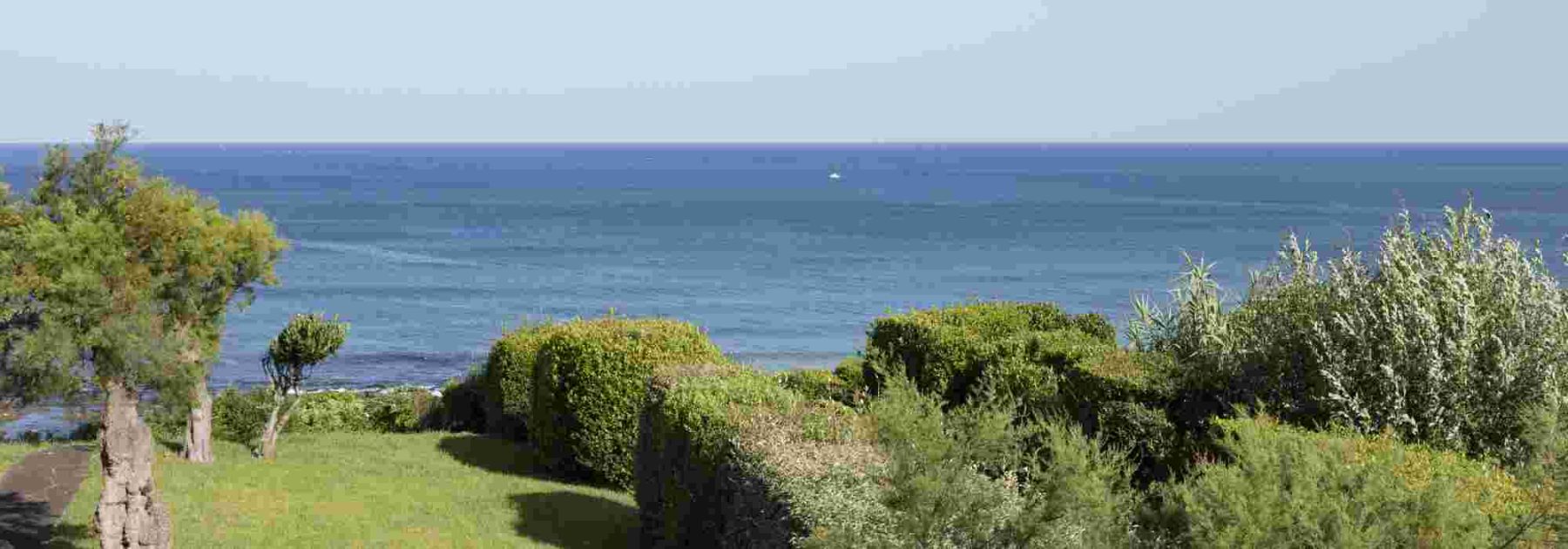
The best bushes for oceanic and coastal climate
Bushes that withstand drying winds, sun and poor soil
Contents
Coastal Gardens are often seen as privileged spaces. But like all outdoor areas, they must contend with certain growing constraints: climate, soil type, exposure, etc. For planting them, it’s therefore preferable to turn to plants specifically adapted to these particular conditions. For this purpose, the bushes for oceanic and coastal climates are perfect candidates. They offer us great diversity of choice and are guaranteed to thrive in an oceanic climate garden, whether slightly inland or right by the sea.
Let’s recap their many assets and see how to choose them for easily creating a beautiful oceanic garden.
The challenges of coastal and oceanic climate gardens
The oceanic climate offers less contrasting seasons than inland areas. Winters are humid but remain fairly mild (in recent years, frosts have rarely exceeded -10°C). Summers, on the other hand, are warm but generally less so than on the Mediterranean coast. With climate change, these areas are increasingly tending towards two main seasons: the wet season and the dry season. Thus, the temperature range between seasons is smaller than in other regions. This is a definite advantage for growing slightly tender plants directly in the ground, but they must also be able to cope with the heat and potential lack of water in summer.
In areas with a true oceanic climate (by the ocean), these gardens must therefore withstand various constraints:
- salt-laden wind (sea spray), which tends to dry out or even scorch plants;
- gusts that can be very strong during storms, weakening or breaking vegetation;
- sun that can be scorching in summer;
- soil that is often well-draining but poor and sandy, lacking organic matter and fertility;
- pH that is generally acidic;
- ground that can be waterlogged in winter during heavy rains.

Coastal gardens are subject to specific weather, humidity and soil conditions
How to combine bushes in a coastal garden?
The constraints of coastal and oceanic climate gardens are quite pronounced. However, there is naturally a vegetation perfectly suited to these areas.
Bushes are essential for structuring and dressing up the garden. There are many varieties to suit all tastes and spaces. Versatile, they can be planted in beds, hedges, borders, rockeries, slopes or pots. These are generally perennial plants that require little maintenance. Their flowering can occur in almost any season. By staggering them, you ensure a lively garden all year round. Their foliage is often one of their ornamental assets. Finally, some can even propagate spontaneously through layering, suckers or sowing.
In coastal and oceanic climate gardens, they will be paired with other plants that tolerate similar conditions.
- Mediterranean perennials. Erigeron, bear’s ears, Delosperma, euphorbias, Dianthus, agapanthus, etc.
- Aromatic plants, such as rosemary, sage, thyme, santolina or curry plants, known for tolerating undemanding conditions.
- Ornamental grasses for dry soil, such as Stipa, Carex, blue fescue, lovegrass, Pennisetum, upright panic grass, etc. Phormium, though a perennial, also resembles ornamental grasses and thrives in coastal areas.
- Trees that tolerate salty and drying winds. This includes certain conifers like pines or Monterey cypress, as well as palms, eucalyptus or holm oak.
- Fruit trees. Fig, olive, jujube, strawberry tree, pomegranate or sea buckthorn thrive in oceanic climate gardens.
- Climbing plants. Bower vine, coral plant, bougainvillea or blue dawn flower.
Also consider native or acclimatised plants. They are naturally suited to withstand local conditions and support local biodiversity. In coastal areas, this includes yuccas, curry plant, heather, gorse, broom, rockroses, strawberry trees, Pittosporum, tamarisk or Russian olive.
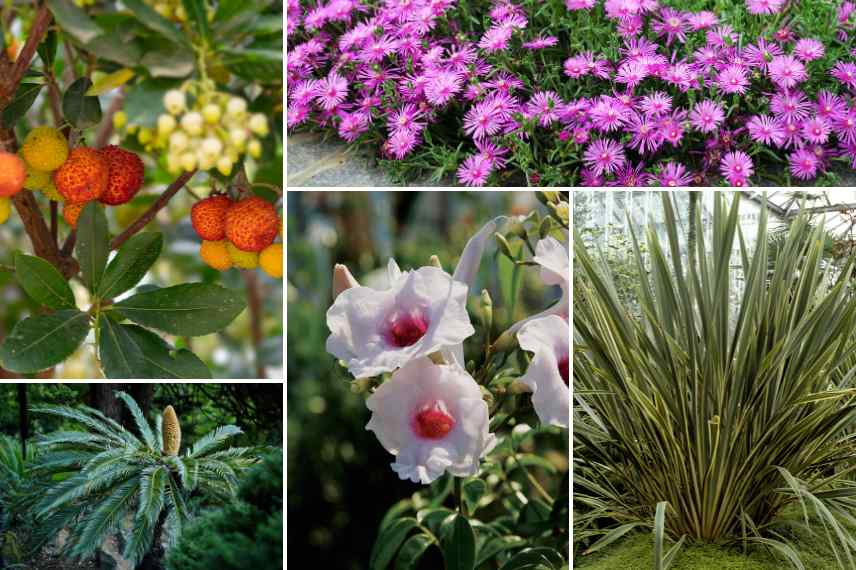
Strawberry tree, Delosperma, Cycas revoluta, Podranea and Phormium
Bushes for an oceanic climate in pots
For container cultivation, it’s preferable to choose bushes suited to coastal conditions, yet maintaining a modest silhouette. Opt for those that don’t exceed 2 to 2.5 metres in height.
This is particularly true for the dwarf Mexican orange, Photinia such as ‘Little Red Robin’, compact oleasters, Hydrangea macrophylla, Loropetalum or container-grown crape myrtles.
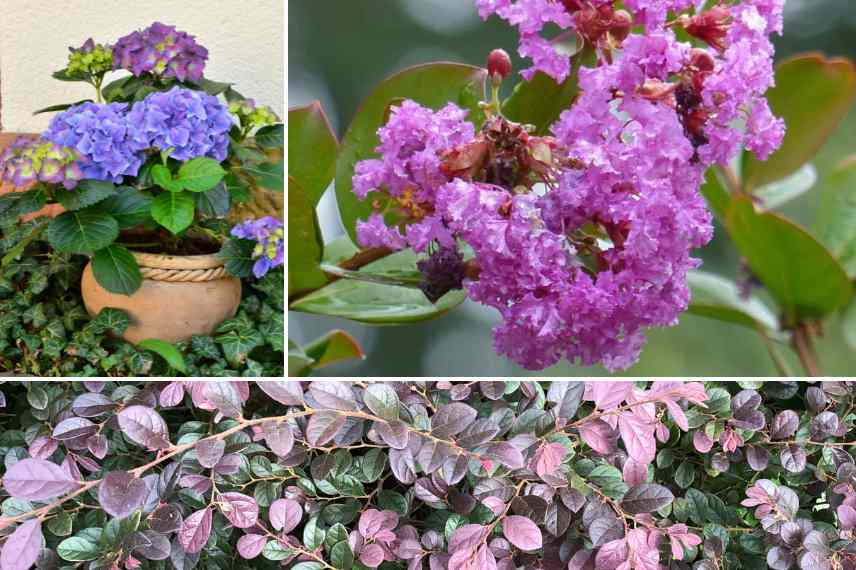
Hydrangea, Lagerstroemia indica ‘Petite Canaille’ and Loropetalum
Bushes for oceanic climate in sunny exposure
In sunny, coastal gardens, bushes must often withstand drought, even if less intense than around the Mediterranean. For this, you can safely turn to Photinia, oleasters, heather, ceanothus, Pittosporum, Escallonia or Japanese spindles.
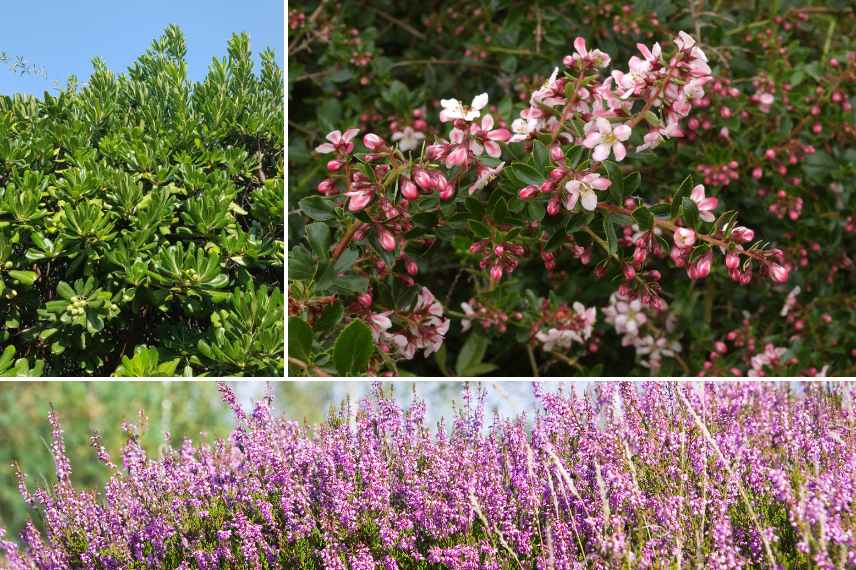
Pittosporum tobira, Escallonia ‘Apple Blossom’ and summer heather
Bushes for oceanic climate in shady locations
In shady locations, you can also successfully grow bushes suited to oceanic conditions. For this purpose, consider for instance heather soil-loving bushes that thrive in the acidic pH of Atlantic coastal gardens. This is particularly true for Hydrangea macrophylla, camellias and rhododendrons.
Let’s also mention Sarcococca with their discreet winter flowering, or fuchsias, many varieties of which are sufficiently hardy to withstand coastal winters.
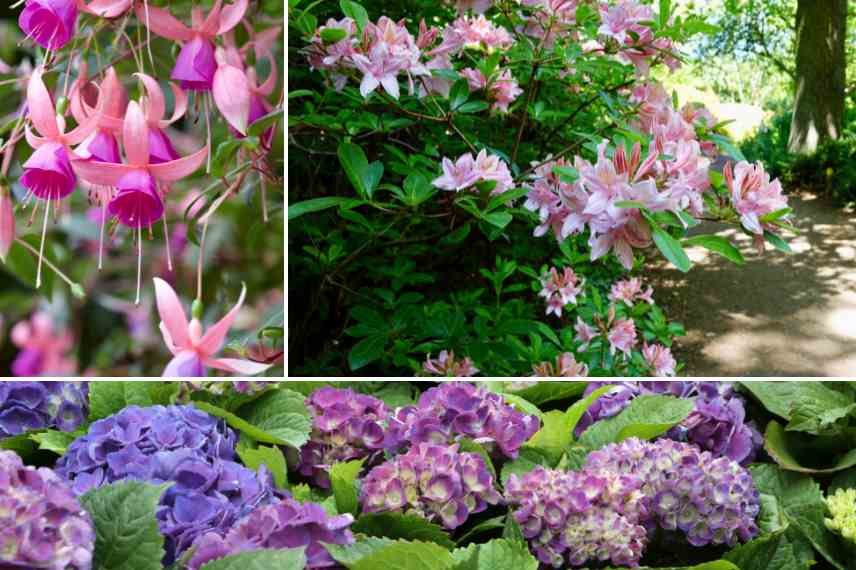
Fuchsia, rhododendron and mophead hydrangea
Colourful-foliaged bushes for oceanic climates
Many bushes from oceanic and coastal climates are evergreen, offering foliage that has the advantage of being decorative all year round. Winters there are indeed mild enough for them to retain their leaves. Moreover, the tough leaves they produce allow them to better withstand summer drought and sunlight.
But some of these bushes also have particularly ornamental foliage, whether in terms of shape or colour. This is obviously the case with Photinias, highly prized for the vibrant colours of their leaves. Also worth mentioning is the magnificent Japanese maple, with its striking red leaves. For a touch of light, consider the Physocarpus opulifolius ‘Lucky Devil’, which boasts golden leaves that turn orange in autumn. The Pseudopanax lessonii ‘Goldfinger’ features deeply cut and dentate foliage with a golden-yellow hue in spring, making it highly ornamental.
Variegated foliage is also very common, particularly with the Euonymus fortunei ‘Emerald Gaiety’, the Elaeagnus ebbingei ‘Limelight’ or the Syringa vulgaris ‘Aucubaefolia’. For an extra touch of originality, opt for the Lophomyrtus ‘Magic Dragon’, a tender New Zealand bush (hardiness around -4°C), but very beautiful with its purple leaves streaked with cream and pink.
For dark foliage that adds charm and contrast, consider the Loropetalum chinense ‘Black Pearl’ or the Hydrangea macrophylla ‘Julisa’. Also worth mentioning is the Lagerstroemia indica ‘Black Solitaire Best Red’, with its almost black foliage.
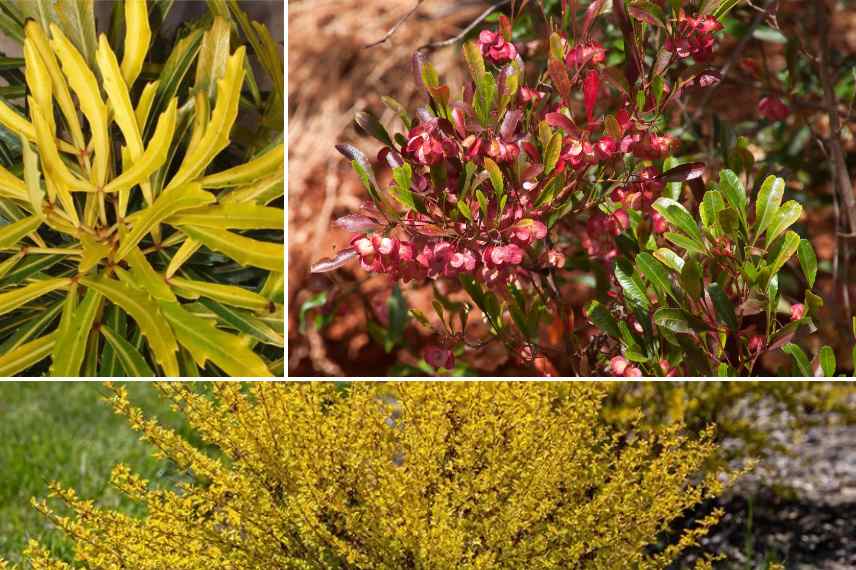
Pseudopanax lessonii ‘Goldfinger’, Dodonea and Physocarpus ‘Lucky Devil’
Fragrant bushes for oceanic climates
Would you also like to enjoy fragrant flowering in your garden, on your terrace or balcony in an oceanic climate? No problem! Let’s start with magnolias, featuring varieties such as ‘White Caviar’, whose late spring to early summer flowering diffuses a scent of ripe banana.
Daphnes are also renowned for their highly fragrant flowering, with floral, sweet and spicy notes, as seen in ‘Spring Beauty’.
Next, let’s mention Osmanthus, small evergreen trees prized for their jasmine-scented flowering.
Don’t overlook the fragrant Pittosporums, nor the Mahonias that brighten winter with their sunny, fragrant flower clusters, delighting foraging insects when food is scarce.
Finally, in autumn, don’t miss the fragrant flowering of Camellia sasanqua.
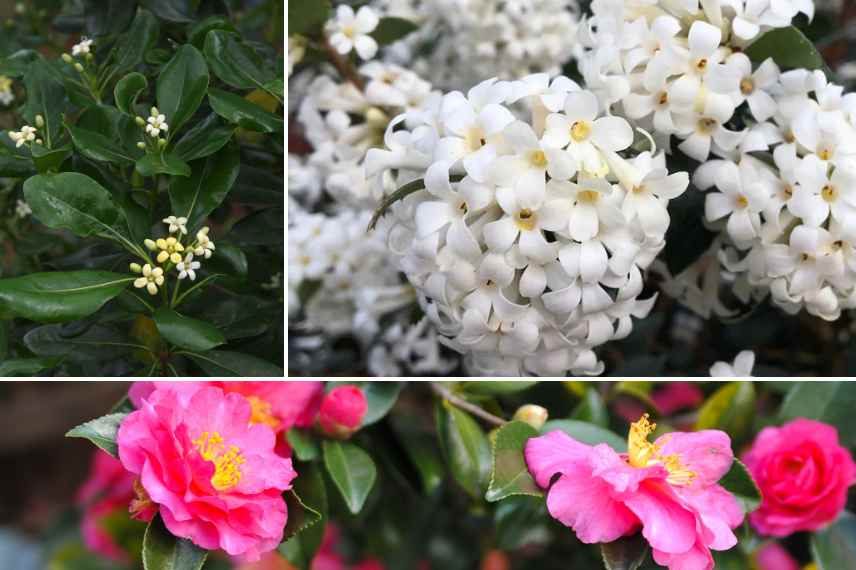
Pittosporum tobira, Osmanthus delavayi ‘Perfume of Nature’ and Camellia sasanqua
How to grow bushes in an oceanic climate?
To facilitate the cultivation of these bushes suited to an oceanic climate, a few additional measures can be implemented.
- Break the wind to reduce the intensity of gusts, for example by installing vegetative barriers or solid structures (reed screens, palisades, heather bundles…). However, do not aim to stop the wind completely, but rather to filter it to reduce its speed, in order to avoid creating eddies or displaced gusts.
- Opt for dense planting, even if it means moving the bushes that can tolerate it once they are well established. The plants will thus protect each other.
- Even if you choose drought-tolerant bushes, it will be essential to water them during the first two years of cultivation, so they can develop their root system in depth. This will allow them to become self-sufficient later on.
- Remember to apply organic mulches at the base of the bushes. This reduces natural evaporation and retains moisture for longer. This measure also prevents the sun and wind from drying out the soil or rain from forming crusts, which would slow down water absorption (a phenomenon known as capping).
- In case of wind damage, prune the damaged shoots and help the plant recover by providing a dose of suitable fertiliser to stimulate regrowth.
- Subscribe!
- Contents





































Comments